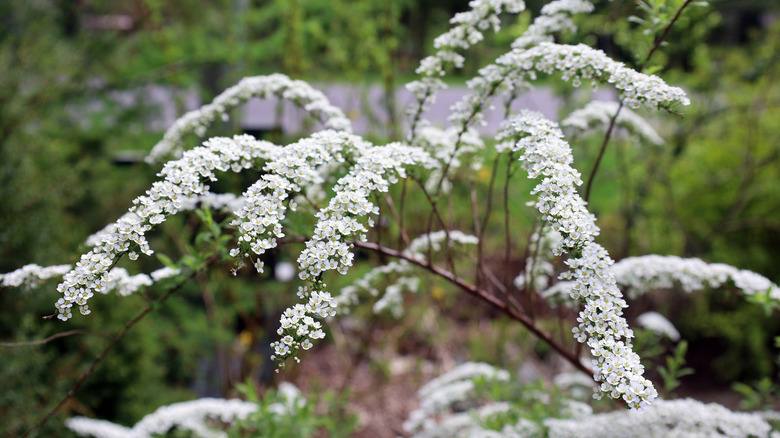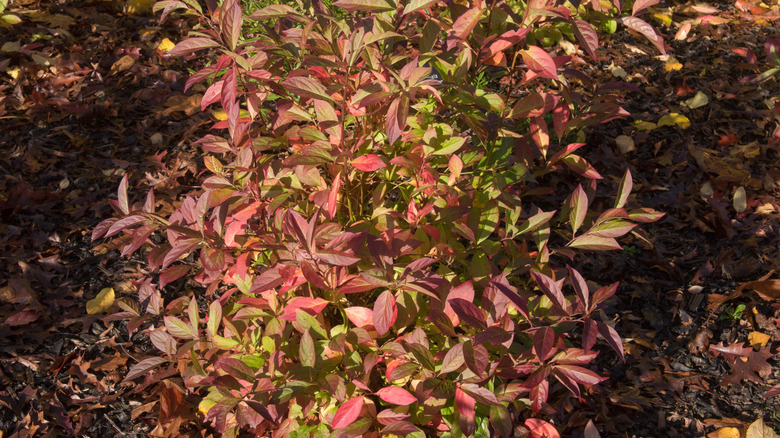Say Goodbye To Fussy Hydrangeas: This Colorful Plant Grows Well Anywhere In The Yard
If you're tired of struggling with shade, sun, and soil pH for your hydrangeas, there's a shrub that can stop these types of gardening headaches before they begin. The Virginia sweetspire (Itea virginica) is a reliable plant that has year-round appeal without the fussiness of hydrangeas, and it's a garden plant you don't have to worry about pruning regularly. Many gardeners love it for its moderate size, adaptability, and the fact that it's attractive year-round. This shrub is able to thrive in a range of conditions, and it's native to the eastern and central United States, growing well in USDA Hardiness Zones 5 through 9.
Unlike many deciduous shrubs that drop their leaves in the fall, the Virginia sweetspire's leaves turn spectacular colors for a fall display. Its cycle begins around mid-June, when lightly fragrant, white flowers appear and last for several weeks. The real show happens in autumn, when the green foliage transforms into shades of orange, yellow, purple, and red, often keeping the colors into the colder months. It's also a popular choice for woodland and pollinator gardens.
How does Virginia sweetspire look in full sun versus shadier areas
Those who are looking for a solution for moist areas in their garden will find that the Virginia sweetspire works quite well since it's naturally found along streams and in wet woodlands. This tolerance for wet soil is one of the plant's main characteristics, making it an excellent choice for stabilizing slopes near water. The shrub adapts well to various soil conditions, growing in acidic, neutral, or alkaline soil, and once established, it has a tolerance for dry conditions. In late spring or early summer, the shrub produces many bottlebrush-like flowers. These white blooms hang from the branches in drooping clusters, sometimes reaching up to 6 inches in length as they attract bees, hummingbirds, and butterflies.
While this flowering shrub thrives in the shade, you should know that the amount of sunlight it gets affects its overall appearance. Plants in full sun produce more flowers and the most vibrant fall colors, while those in heavier shade may grow taller and looser with less intense fall foliage colors.
Why Virginia sweetspire is the perfect choice for tough spots in your yard
One of the great features of this shrub is its natural habit of forming colonies, allowing it to quickly fill in those empty spaces in the yard. Virginia sweetspire is a multi-stemmed plant with arching branches that forms a rounded shape, growing about 4 to 8 feet tall with a similar width. For gardeners who are interested in a smaller plant, there are compact varieties like 'Little Henry,' which stays closer to 2 to 3 feet tall, or 'Merlot,' known for its dark red fall color. The plant spreads by sending out underground runners, or suckers, from its roots. This means it will go from being one shrub to a dense clump or even a small thicket, making the plant look fuller and eliminating bare ground around the base.
This habit is useful for large-scale landscaping projects or when you need a border plant that will fill up a large area quickly. Because of its spreading root system, it's often used for erosion control where other plants struggle to hold on to the soil. The Virginia sweetspire is also resistant to deer, which is an advantage for gardeners who live in areas with large deer populations. You can feel confident planting this shrub anywhere in your yard, knowing it will adapt to whatever light and moisture it gets. If you start to notice brown leaves on your Virginia sweetspire, don't worry — it's easily fixable, and the plant is rarely bothered by pests or serious diseases. To prevent spreading, pull up the suckers as soon as they appear.


